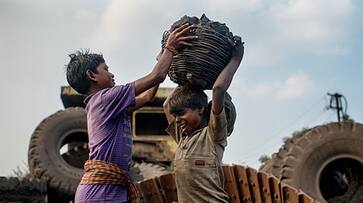In India, isn't Children's Day a mere eyewash, a farce?
- While the relative rate of female infanticide in India has gone down across years, it is still among the highest in the world.
- The female child population in the age group of 0-6 years declined from 78.83 million in 2001 to 75.84 million in 2011.
- According to a 2011 census, India is said to be home to approximately 117 lakh child labourers.

Children's Day every year brings us memories back from school and the innumerable lectures on how children are the future of the nation and how much they were loved by the first Prime Minister of India-Pandit Jawaharlal Nehru, fondly remembered as Chacha Nehru. The red rose on his jacket symbolised the love he shared with young children and how he dreamt of a progressive country that did justice to its young talents.
However, little did he know that India would progress, cerainly, but at a pace that is beyong imagination. The poverty that was there 100 years ago would continue to loom large over the youth of the nation. Malnutrition, lack of employment, infant mortality rates and children deaths due to disease still continue to be the same.
The Ministry of Health and Family Welfare's press release on the latest trends in infant mortality rate is optimistic, but the fact that it still continues to haunt the socio-economic scene of the country cannot be ignored. The rate has dropped by 3 points since 2014, it says, which means there has been an 8% decline.
Female Infanticide
Moreover, the gender gap is also reducing, implying that the government has been successful in building awareness about the importance of birth child. Female infanticide has reduced, no doubt, but it still exists. Experts, however, believe that there is nothing to be happy about the situation since this will continue until social evils like dowry and rape are eliminated.
According to a report by downtoearth.org, in the first ever global study on female infanticide by Asian Centre for Human Rights, a Delhi-based NGO revealed dowry system in South Asia, which makes daughters “an unaffordable economic burden”, contributes to female infanticide. Fear of being sexually exploited and losing honour due to rape are some of the other inhibitions that parents have toward a girl child, leading to infant deaths.
While the relative rate of female infanticide in India has gone down, it is still among the highest in the world. Consider this, the female child population in the age group of 0-6 years declined from 78.83 million in 2001 to 75.84 million in 2011. During the period 1991-2011, the child sex ratio (0-6 years) declined from 945 to 914. Despite regulations like Pre-natal Diagnostic Techniques (Regulation and Prevention of Misuse) Act, 1994 (PNDT Act), Medical Termination of Pregnancy (MTP) Act, the ministry of Health and Family Welfare has acknowledged that illegal abortions still outnumber legal abortions. As per the Population Research Institute at least 12,771,043 sex-selective abortions had taken place in India between 2000 and 2014. This takes the daily average of sex-selective abortion to 2,332.
Child Labour
The Child Labour Amendment is a clear failure of administration since it discounts the poverty factor that leads to increasing rate of employment among children. According to a 2011 census, India is said to be home to approximately 117 lakh child labourers. But there is no way that this will go down unless malnutrition and poverty indices go down. Moreover lack of awareness among their employers add to the woes of the society. Most of them have a collective consciousness that employing children is helping them get rid of their poverty, but little do they realise the psychological effect employment has on the children. Exposure to drugs, criminal activities are some of the solid grounds on which people should avoid employing children.
Having said that, it is also true that most of them are often being physically and financialy exploited either by their employers or the members of their families which brings them back where they started from. In a report by the Youth ki Awaz, data provided by the Bachpan Bachao Andolan states that between January 2010 and December 2014, 5,254 children were rescued from situations of exploitative labour. 21% of those below 14 years were employed with family members. 83% of all the children were rescued from home-based units; under the proposed revisions. With no prescribed or practical method to determine relation to the child, rescuing these children will be a bigger challenge as the employers can now, with legal protection, claim to be the child’s relatives.
Child Trafficking and Child Abuse
In a report released by the Ministry of Women and Child Development in 2007, it has been estimated that 150 million girls and 73 million boys under 18 have been subjected to forced sexual intercourse or other forms of sexual violence.
In 2002 there were 53,000 reported cases of child homicide. The same study found that 69% of children are reported to have been physically abused. Out of these 54.68% were boys. 52.91% of boys and 47.09 % of girls reported having been abused in their family environment. Of the children who were abused in family situations, 88.6% were abused by their parents. Thus, lies the stark reality of the Indian social structure where children are not even safe in their won houses.
Most of these data go unnoticed because of lack of reportage and the inherent feeling among families that this will only bring shame to them, nothing else. However, they forget that discounting them as mere instances is multiplying their probabilities of occurrances.
Does celebrating Children's Day really hold any importance in the above-given situation? For all that matters in the present scenario, it is just an eyewash, a farce that makes people celebrate India as a nation, minus the challenges it faces when it comes to giving its children a healthy environment to grow in.














